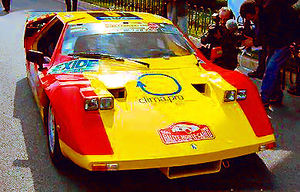Difference between revisions of "Tanesini"
m |
m |
||
| (One intermediate revision by the same user not shown) | |||
| Line 7: | Line 7: | ||
| − | The "Cartanfruit" prototype, driven by the [[Italian]] [[Giuliano Mazzoni]], won the [[FIA]] Alternative Energies Cup 8 times. This car, built by the amateur Tanesini, was equipped with 3 electric motors with a total power of 150 kW, equivalent to about 200 hp, and capable of a speeds of over 200 km/h. The ''Tanesini Cartanfruit'' used heavy lead/acid batteries not a sophisticated hybrid system with superconductors nor lithium-ion batteries; remarkable. By comparing the results ([[circuit]] or [[hill-climb]] races) with the results achieved by the endothermic cars, this [[electric vehicle]] was faster than many traditional [[race car]] [[prototypes]]. | + | The "Cartanfruit" prototype, driven by the [[Italian]] [[Giuliano Mazzoni]], won the [[FIA]] Alternative Energies Cup 8 times. This car, built by the amateur Tanesini, was equipped with 3 electric motors with a total power of 150 kW, equivalent to about 200 hp, and capable of a speeds of over 200 km/h. The ''Tanesini Cartanfruit'', driven by team ''Selene'', used heavy lead/acid batteries not a sophisticated hybrid system with superconductors nor lithium-ion batteries; remarkable. On race day, Japanese engineers at the race dubbed it "the electric Ferrari" on the first day and the name stuck. By comparing the results ([[circuit]] or [[hill-climb]] races) with the results achieved by the endothermic cars, this [[electric vehicle]] was faster than many traditional [[race car]] [[prototypes]]. On some stages, the car's winning average speed was 50 mph, which the columnist says is not bad considering the hairpin turns and the uphill terrain of the race course. |
Latest revision as of 08:08, 11 July 2010
1997
The "Cartanfruit" prototype, driven by the Italian Giuliano Mazzoni, won the FIA Alternative Energies Cup 8 times. This car, built by the amateur Tanesini, was equipped with 3 electric motors with a total power of 150 kW, equivalent to about 200 hp, and capable of a speeds of over 200 km/h. The Tanesini Cartanfruit, driven by team Selene, used heavy lead/acid batteries not a sophisticated hybrid system with superconductors nor lithium-ion batteries; remarkable. On race day, Japanese engineers at the race dubbed it "the electric Ferrari" on the first day and the name stuck. By comparing the results (circuit or hill-climb races) with the results achieved by the endothermic cars, this electric vehicle was faster than many traditional race car prototypes. On some stages, the car's winning average speed was 50 mph, which the columnist says is not bad considering the hairpin turns and the uphill terrain of the race course.
Send what you got to:
| Car Information and Photos by Marque: A - B - C - D - E - F - G - H - I - J - K - L - M - N - O - P - Q - R - S - T - U - V - W - X - Y - Z |
| Motorcycle Information and Photos by Marque: A - B - C - D - E - F - G - H - I - J - K - L - M - N - O - P - Q - R - S - T - U - V - W - X - Y - Z |

